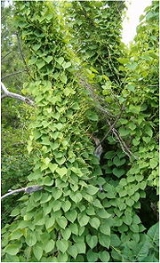
Dioscoreaceae
Encyclopedia
Dioscoreaceae is a family
of monocotyledon
ous flowering plants, with about 750 species
in eight or nine genera
. The best-known member of the family is the Yam
(Dioscorea
).
The APG system
(1998) and APG II system
(2003) both place it in the order Dioscoreales
, in the clade monocots. However, the circumscription changed in the APG II system, with the 2003 system expanded to include the plants that in the 1998 system were treated in the families Taccaceae and Trichopodaceae.
(Taccaceae)
(Trichopodaceae)
Family
In human context, a family is a group of people affiliated by consanguinity, affinity, or co-residence. In most societies it is the principal institution for the socialization of children...
of monocotyledon
Monocotyledon
Monocotyledons, also known as monocots, are one of two major groups of flowering plants that are traditionally recognized, the other being dicotyledons, or dicots. Monocot seedlings typically have one cotyledon , in contrast to the two cotyledons typical of dicots...
ous flowering plants, with about 750 species
Species
In biology, a species is one of the basic units of biological classification and a taxonomic rank. A species is often defined as a group of organisms capable of interbreeding and producing fertile offspring. While in many cases this definition is adequate, more precise or differing measures are...
in eight or nine genera
Genus
In biology, a genus is a low-level taxonomic rank used in the biological classification of living and fossil organisms, which is an example of definition by genus and differentia...
. The best-known member of the family is the Yam
Yam (vegetable)
Yam is the common name for some species in the genus Dioscorea . These are perennial herbaceous vines cultivated for the consumption of their starchy tubers in Africa, Asia, Latin America and Oceania...
(Dioscorea
Dioscorea
Dioscorea is a genus of over 600 species of flowering plants in the family Dioscoreaceae, native throughout the tropical and warm temperate regions of the world. The vast majority of the species are tropical, with only a few species extending into temperate climates...
).
The APG system
APG system
The APG system of plant classification is the first, now obsolete, version of a modern, mostly molecular-based, system of plant taxonomy that was published in 1998 by the Angiosperm Phylogeny Group. It was superseded in 2003 by a revision, the APG II system, and then in 2009 by a further...
(1998) and APG II system
APG II system
The APG II system of plant classification is the second, now obsolete, version of a modern, mostly molecular-based, system of plant taxonomy that was published in April 2003 by the Angiosperm Phylogeny Group. It was a revision of the first APG system, published in 1998, and was superseded in 2009...
(2003) both place it in the order Dioscoreales
Dioscoreales
Dioscoreales is a botanical name for an order of flowering plants. Of necessity it contains the family Dioscoreaceae.In the APG II system, of 2003, this order was placed in the clade monocots and comprised the families Burmanniaceae, Dioscoreaceae and Nartheciaceae.Under the APG system of 1998,...
, in the clade monocots. However, the circumscription changed in the APG II system, with the 2003 system expanded to include the plants that in the 1998 system were treated in the families Taccaceae and Trichopodaceae.
Genera
Dioscoreaceae (sensu stricto)- Borderea
- DioscoreaDioscoreaDioscorea is a genus of over 600 species of flowering plants in the family Dioscoreaceae, native throughout the tropical and warm temperate regions of the world. The vast majority of the species are tropical, with only a few species extending into temperate climates...
- Epipetrum
- Rajania
- Stenomeris
- TamusTamusTamus is a genus of one or two species of flowering plants in the family Dioscoreaceae, native to Europe, northwestern Africa, and western Asia. The genus is now often included within the related genus Dioscorea, but is maintained as distinct by some authors.Species*Tamus communis L. -References:***...
(often included in Dioscorea)
(Taccaceae)
- TaccaTaccaThe genus Tacca, which includes the Bat flowers and Arrowroot, consists of ten species of flowering plants in the order Dioscoreales, native to tropical regions of Africa, Australia, and south-eastern Asia. In older texts, the genus was treated in its own family Taccaceae, but the 2003 APG II...
(Trichopodaceae)
- Avetra
- Trichopus
External links
- Dioscoreaceae, Taccaceae, Trichopodaceae in L. Watson and M. J. Dallwitz (1992 onwards), The families of flowering plants
- Monocot families (USDA)
- Flora of North America: Dioscoreaceae
- NCBI Taxonomy Browser
- Dioscoreaceae links, Taccaceae links, Trichopodaceae links at CSDL, Texas

